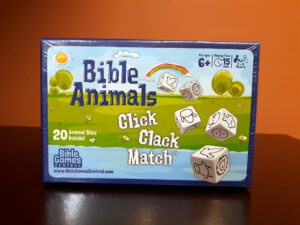This will be the third of the five Christian games I review this year for Bible Games Central. I’ve already reviewed Mission: Ends of the Earth and Bible Animals: Click Clack Match, outlining the strengths and weaknesses of each. In today’s review, I’ll be looking at The Good Shepherd, a Bible-themed card game.
As always, first the discloser: Nobody has paid me for this review, nor have I been asked to skew it. Rather, what I say is my own objective (as I can be) opinion.
As stated, The Good Shepherd is a Christian card game in which players try to earn the most points by collecting groups of cards—sheep and pastures. Like the other game reviews, I’ll begin by looking at the The Good Shepherd’s design and construction, then the overall gameplay, followed by outlining the weaknesses, and finally I’ll offer my final thoughts and recommendations.
The Good Shepherd
Materials, Design, and Construction
The Good Shepherd comes in a standard card box, with the one slight improvement: the flap opens up a little below the rest of the box, allowing easier access to the deck. The card size seems a bit smaller than normal playing cards such as Bicycle brand game cards, but that might make them easier for those with smaller hands to hold. Although they are smaller, they are as thick as standard card and laminated, improving their durability.
An apparent staple of Bible Game Central—besides their focus on evangelism and Bible lessons—is their use of colors. The Good Shepherd uses bright, bold colors that create a nice contrast between the sheep cards (blue, purple, and green) and the trouble cards (orange wolf and red stampede).
As always, the instructions are not cheap printed paper, but double-sided, laminated, foldable card stock. Like the cards, the print is easy to read and colorful.
Click each photograph below to see full size.
Overall Gameplay
The gameplay of The Good Shepherd is fairly straightforward and, at least to me, has some similarities to Uno: players not only draw and discard cards, they can also claim one or more of the other player’s cards. The goal is to have the most points at the end of the game.
Sheep and pasture cards have point values from 1-10, with a special sheep card worth 100 points (technically, “99+1”). In order to win points, one must have both a pasture and a sheep card.
Players take turns drawing and discarding cards, and they can use Wolf and Stampede cards to take cards from other players. Shepherd cards are used to protect against Wolf and Stampede cards, and Sundown cards are used to determine when the game ends.
The game ends once a specific number of Sundown cards are played; the number required is dependent upon the number of players. Once the game ends, the player with the most points wins.
Weaknesses of the Game
There are two main weaknesses to The Good Shepherd. The first regards the instructions and the second is in the gameplay.
The instructions for The Good Shepherd are, at times, unclear and could use some editing and revision. For example, the instructions state that a player must have “at least 1 Sheep Card AND 1 Pasture Card to score any points.” While it’s likely this simply means that a pasture card is needed in order to play a sheep card, it could also be read to mean that only one sheep card can be played with a pasture card. A slight clarification would help.
Additionally, the instructions shift suddenly from the Stampede cards to the Sundown cards and then back to the Stampede cards without any clear transition. Additionally, there is also no clear explanation in this shift of what the Sundown cards do; that comes two paragraphs later.
When it comes to gameplay, there are two areas where things are unclear or could be simplified. First, the game ends when a specific number of Sundown cards are played, and that number is determined by the number of players. According to the printed instructions, for games with 2-3 players, the game ends when 3 Sundown cards are played; for 4-6 players, it’s when 5 Sundown cards are played. However, there are a total of 6 Sundown cards in the deck. Why have the sixth card? Why do ranges? A simpler solution is to state that the game ends when the number of Sundown cards played matches the number of players in the game (the game is designed for up to six players).
Second, the inclusion of a 100-point card guarantees that the player who has the special card will win since the most points other players could have is 20-30. Thus, the game becomes less about the flock and more about a single “sheep” (though, admittedly, that could be the point, a play off of the idea of leaving the ninety-nine to save the one).
Final Thoughts and Recommendations
The Good Shepherd has the potential to be a fun Christian card game for families or small groups (time allowing). Younger players will enjoy gathering cards and looking for opportunities to steal other players cards in order to garner points. However, limiting each player’s hand to three cards could reduce older player’s interest, thus I think increasing it to five would be better.
Despite the weaknesses in the instructions and gameplay, I believe most people will find The Good Shepherd a creative Bible-based game that fosters socialization and fellowship while allowing people to have a good time.























